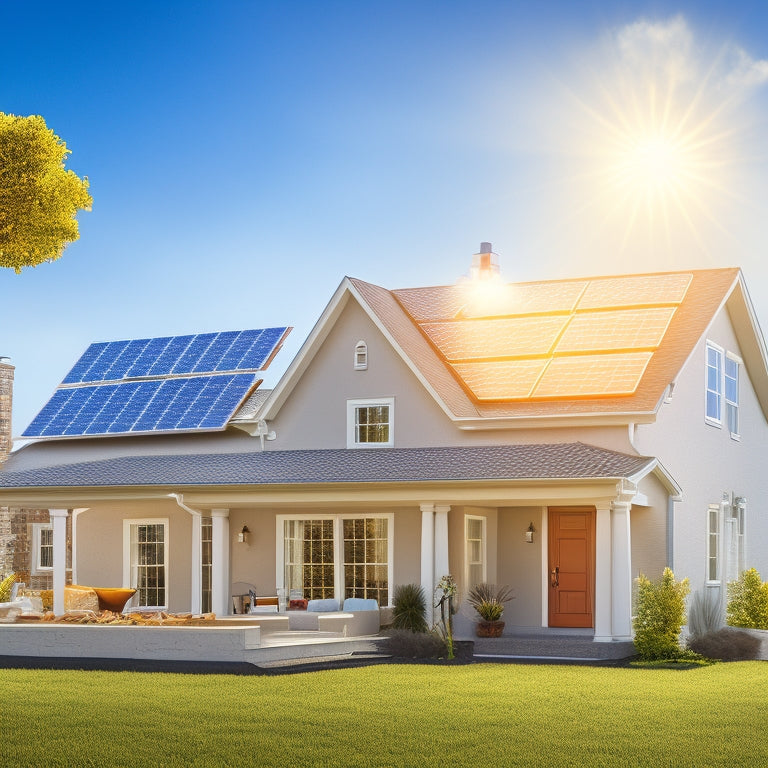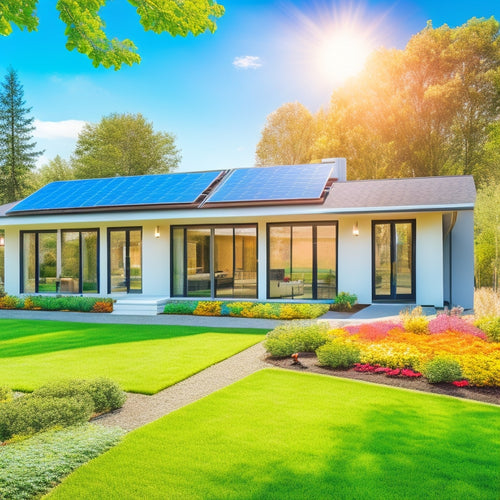
Costs to Consider for Installing Solar Panels on Your Home
Share
As you contemplate installing solar panels on your home, you'll need to factor in various costs, including the initial investment and financing options, which can range from $15,000 to $30,000. You'll also need to take into account roof size and complexity, the type and quality of equipment, and installation labor costs, which account for nearly 40% of the total cost. Additionally, permits, inspection fees, and potential upgrades to your electrical connection will add to the overall expense. Moreover, you'll need to think about long-term costs like monitoring, maintenance, and potential inverter replacement. Understanding these costs will help you make an informed decision about going solar.
Key Takeaways
- The upfront cost of installing solar panels ranges from $15,000 to $30,000, but financing options and tax credits can reduce the financial burden.
- Roof size, complexity, and obstacles like skylights and chimneys can increase installation costs and affect energy production.
- The type and quality of equipment, including solar panels and inverters, impact overall costs and energy efficiency, with higher-efficiency panels yielding more power.
- Installation labor costs, including licenses and certifications, account for nearly 40% of total costs, and experienced installers can reduce waste and wait time.
- Additional costs to consider include permits and inspection fees, electrical connection upgrades, battery backup systems, monitoring and maintenance, and inverter replacement costs.
Initial Investment in Solar Panels
Your wallet takes a considerable hit when you decide to harness the power of the sun. The initial investment in solar panels can be substantial, but there are ways to make it more manageable.
The total cost of installation includes the price of the panels, inverters, mounting hardware, and labor. On average, the upfront cost of a solar panel system ranges from $15,000 to $30,000. However, you can examine financing options to spread the cost over time. Many solar panel installers offer financing plans with low or no down payment, and some even provide zero-interest loans.
Additionally, you can benefit from tax incentives. The federal government offers a 26% tax credit on the total cost of the system, which can greatly reduce your taxable income.
Some states and utilities also provide rebates and incentives, further reducing the upfront cost. By taking advantage of these financing options and tax incentives, you can make the initial investment in solar panels more affordable and start generating clean energy for your home.
Roof Size and Complexity
When you're planning to install solar panels, you'll need to evaluate your roof's size and complexity.
You'll have to maneuver around roof obstacles and barriers, such as skylights, vents, and chimneys, which can increase installation costs.
Additionally, the space and orientation of your roof will impact the number of panels you can fit and their energy output.
Roof Obstacles and Barriers
Roof size and complexity are significant factors in determining the costs of installing solar panels. You'll need to examine the size of your roof and how it will affect the number of panels you can install. A larger roof means more panels, which increases the overall cost.
Additionally, complex roof designs with multiple angles, skylights, or vents can make installation more challenging and expensive.
You'll also need to evaluate your roof's materials and condition. Certain roof materials, such as asphalt shingles, may require additional installation steps, adding to the cost.
Furthermore, if your roof is old or damaged, you may need to replace it before installing solar panels, which can be a significant added expense.
Shading issues from trees, chimneys, or other obstructions can also impact the performance of your solar panels and increase the cost of installation.
Space and Orientation
Solar panel installation costs are heavily influenced by the available space and orientation of your roof. The size and complexity of your roof will impact the number of solar panels you can install, which in turn affects the overall cost.
You'll need to evaluate the roof's pitch, orientation, and obstructions like skylights, vents, or chimneys that may limit solar access. A shading analysis will help identify areas that receive partial or full shade, affecting energy production.
The ideal roof orientation for solar panels is south-facing, as it receives the most direct sunlight. East- and west-facing roofs can also work, but north-facing roofs are generally not suitable.
The roof's size will also impact the cost, as larger roofs require more materials and labor. Additionally, complex roofs with multiple angles or levels may require more specialized equipment and installation techniques, increasing costs.
Type and Quality of Equipment
Several factors affect the costs of installing solar panels, and the type and quality of equipment you choose play a significant role in determining the overall cost.
The type of solar panel you select can greatly impact the final bill. For instance, monocrystalline solar panels are more expensive than polycrystalline ones, but they're also more efficient.
When it comes to equipment quality, you'll want to take into account the following:
- Efficiency ratings: Higher efficiency ratings mean more power per hour of sunlight.
- Equipment warranties: Look for warranties that cover at least 25 years to guarantee your investment is protected.
- Certifications and compliance: Verify your equipment meets local and national standards for safety and performance.
- Brand reputation: Research the manufacturer's reputation for producing high-quality, reliable equipment.
Installation Labor Costs
When you're evaluating installation labor costs, you'll want to take into account the installer's licenses and certifications, which can impact the quality of the work.
A reputable installer will also have quality control measures in place to guarantee the work meets industry standards.
Additionally, you'll want to assess the installer's time and efficiency, as a more experienced installer can complete the job faster and with less waste.
Licenses and Certifications
About 10% of your total installation labor cost goes towards obtaining necessary licenses and certifications, an essential aspect of verifying your solar panel system is installed safely and efficiently.
This investment guarantees that your solar panel system meets local building codes and standards, giving you peace of mind and eligibility for incentive programs and financing options.
To get a better understanding of what's involved, consider the following:
-
Electrical permits: These are required to verify your solar panel system is installed to code and meets safety standards.
-
Building permits: These verify that your solar panel system is structurally sound and compliant with local building codes.
-
Certifications from manufacturers: These guarantee that your solar panels and equipment meet specific quality and performance standards.
- Inspections and testing: These are conducted to verify your solar panel system is installed correctly and functioning as expected.
Workmanship Quality Control
Your solar panel installation's overall quality depends on the workmanship quality control, which accounts for a significant portion of your installation labor costs. You want to guarantee that your solar panel system is installed correctly and safely, meeting the required installation standards.
A reputable contractor with extensive experience in solar panel installations is essential in achieving this. They'll have the necessary proficiency to handle complex roofing and electrical connections, guaranteeing a secure and efficient installation.
You should look for contractors who've completed rigorous training programs and have a proven track record of successful installations. Their experience will help minimize errors, reduce the risk of accidents, and guarantee compliance with local building codes and regulations.
Additionally, a skilled contractor will be able to identify potential issues before they become major problems, saving you time and money in the long run. By investing in a contractor with a strong workmanship quality control process, you'll get a solar panel system that's both reliable and efficient, providing you with clean energy for years to come.
Time and Efficiency
Nearly 40% of your total installation costs can be attributed to labor, making time and efficiency vital factors in the overall expense of installing solar panels. The more time it takes to complete the installation, the higher your labor costs will be.
This is why it's essential to choose an experienced and skilled installation team that can complete the job quickly and efficiently.
Here's what you should consider when it comes to time and efficiency:
-
Installation speed: A slower installation process can lead to higher labor costs and a longer wait time before you can start generating clean energy.
-
Energy production efficiency: The efficiency of your solar panels can impact your energy production and overall savings. Look for high-efficiency panels to maximize your energy output.
-
Solar panel lifespan: The lifespan of your solar panels can affect your long-term energy production and savings. High-quality panels can last up to 30 years or more.
- System design complexity: A more complex system design can require more time and labor to install, increasing your overall costs.
Permits and Inspection Fees
Frequently, homeowners overlook the necessary permits and inspection fees involved in installing solar panels, which can add up quickly to the overall cost of the project. As you consider installing solar panels on your home, it's crucial to factor in these costs to guarantee a smooth and compliant installation process.
Permits and inspection fees vary depending on your location, system size, and local regulations. You'll need to obtain permits from your local government, which may include:
| Type of Permit | Description | Average Cost |
| Building Permit | Required for structural changes to your home | $500-$1,000 |
| Electrical Permit | Required for electrical connections and wiring | $200-$500 |
| Zoning Permit | Assures compliance with local zoning regulations | $100-$300 |
| Inspection Fees | Required for inspections during and after installation | $500-$1,000 |
These permits and fees guarantee your solar panel installation meets local building codes, zoning regulations, and inspection requirements. Be sure to research the specific requirements for your area to avoid unexpected costs and delays.
Electrical Connection Upgrades
To guarantee a safe and efficient connection to the grid, your solar panel system may require electrical connection upgrades. This is because your existing electrical infrastructure mightn't be compatible with the new system. Confirming grid compatibility is vital to avoid any potential safety hazards and optimize energy production.
You may need to upgrade the following components:
-
Main electrical panel: Your current panel mightn't have enough capacity to handle the added power from your solar panels. Upgrading to a larger panel or installing a separate panel for your solar system might be necessary.
-
Wiring requirements: The wiring in your home may need to be upgraded to accommodate the increased electrical load. This could include installing heavier-gauge wiring or rewiring entire sections of your home.
-
Circuit breakers: Your existing circuit breakers mightn't be designed to handle the unique power output of solar panels. Upgrading to specialized breakers that can handle the DC power output of your solar system is essential.
- Grid tie inverter: This device synchronizes your solar panel system with the grid, guaranteeing a safe and efficient transfer of energy. You may need to install a new inverter or upgrade your existing one to confirm compatibility with your solar panel system.
These upgrades will guarantee a safe and efficient connection to the grid, allowing you to maximize your energy production and savings.
Battery Backup Systems
Many homeowners opt for battery backup systems to guarantee a steady supply of electricity during grid outages or at night when their solar panels aren't producing energy. This energy storage solution provides you with energy independence, reducing your reliance on the grid.
When considering a battery backup system, you'll want to think about the battery lifespan, typically ranging from 10 to 15 years, and how it will impact your overall energy costs.
You'll also want to investigate the financial incentives available for installing a battery backup system, such as state and federal tax credits. Additionally, you'll need to verify system compatibility with your existing solar panel system and grid interaction.
The installation timeline for a battery backup system typically takes a few days to a week, depending on the complexity of the installation.
When choosing a battery technology, consider the environmental impact and look for systems with a minimal carbon footprint.
With a battery backup system, you'll have emergency preparedness and peace of mind, knowing you'll have power when you need it.
Monitoring and Maintenance
As you've guaranteed a steady supply of electricity with a battery backup system, it's now important to reflect on how you'll keep tabs on your solar panel system's performance and address any issues that may arise.
You'll need to invest in monitoring technology that tracks your system's energy production, identifies potential problems, and alerts you to take corrective action. This technology can be accessed remotely through mobile apps or web platforms, giving you real-time observations into your system's performance.
Here are some key aspects of monitoring and maintenance to reflect on:
-
Performance monitoring: Track your system's energy output to verify it's meeting expected levels.
-
Alert systems: Receive notifications when issues arise, such as panel malfunctions or energy drops.
-
Routine maintenance: Schedule regular checks to clean panels, inspect connections, and replace worn-out components.
- Data analysis: Use performance data to optimize your system's configuration and identify opportunities for enhancement.
Inverter Replacement Costs
Your solar panel system relies on an important component: the inverter, which converts DC power from the panels into usable AC power for your home. This vital device is responsible for maximizing your system's energy output, and its failure can greatly impact your energy savings.
As you evaluate the costs of installing solar panels, it's important to factor in inverter replacement costs.
Inverter technology has evolved greatly over the years, leading to more efficient and reliable systems. However, even with advancements, inverters have a limited lifespan, typically ranging from 10 to 15 years. As your inverter reaches the end of its lifespan, you'll need to budget for replacement.
The cost of a new inverter can range from $1,000 to $3,000, depending on the type and quality of the device.
It's vital to evaluate inverter replacement costs when calculating the total cost of ownership for your solar panel system. By factoring in this expense, you can guarantee a smooth changeover when your inverter needs to be replaced, and you can continue to enjoy the benefits of solar energy for years to come.
Warranty and Repair Expenses
The solar panel system you've installed comes with warranties and guarantees that protect your investment. These warranties typically cover the system's performance, components, and workmanship for a certain period. Understanding the warranty and repair expenses is vital to guarantee you're prepared for any potential issues that may arise.
Here are some key aspects to take into account:
-
Warranty duration: The length of time the manufacturer's warranty is valid, usually ranging from 10 to 25 years.
-
Repair coverage: The extent of repairs covered under the warranty, including labor and replacement costs.
-
Maintenance requirements: Regular maintenance tasks you need to perform to keep the warranty valid.
- Extended warranty options: Optional extended warranty periods or additional coverage you can purchase for added protection.
When evaluating the warranty and repair expenses, take into account the warranty duration, repair coverage, and maintenance requirements. This will help you budget for potential future costs and guarantee your solar panel system operates efficiently and effectively.
Frequently Asked Questions
Can I Install Solar Panels on a Rented Property?
You'll need to review your renter agreements and obtain installation permissions from your landlord before installing solar panels on a rented property, ensuring you're not violating any terms and can negotiate a beneficial arrangement.
Will Solar Panels Increase My Property Taxes?
When you install solar panels, you'll want to know if they'll increase your property taxes. The answer depends on your location; some states offer solar panel exemptions from property tax assessment, while others don't, so you'll need to check your local laws.
Can I Add Solar Panels to an Existing Solar System?
You can expand your existing solar setup by adding more panels, but you'll need to verify system compatibility, checking factors like voltage, wattage, and connector type to guarantee a seamless solar panel expansion that maximizes your energy output.
Are There Any Solar Panel Recycling Programs Available?
As you weigh the eco-friendly benefits of solar energy, you'll be relieved to know that you're not stuck with decommissioned panels; instead, you can rely on emerging solar panel recycling programs to responsibly handle solar panel disposal, mitigating environmental impact.
Do Solar Panels Work During a Power Outage?
You're wondering if solar panels work during a power outage; unfortunately, they don't, as they're designed to feed excess energy back into the grid. However, you can consider power outage solutions like energy storage systems to maximize solar panel efficiency.
Conclusion
As you weigh the benefits of solar panels, remember that the initial investment is just the starting point. Think of it like planting a tree - you need to take into account the soil, watering, and pruning costs to guarantee it grows strong. Similarly, factor in the costs beyond the initial installation, like roof complexity, equipment quality, and maintenance, to reap the full rewards of solar energy. By doing so, you'll be harvesting clean energy for years to come.
Related Posts
-
Trends in Renewable Energy Storage Technologies
You're witnessing rapid advancements in renewable energy storage technologies aimed at improving efficiency and scala...
-

How Solar Panels Increase Property Value
Installing solar panels considerably increases your property value by improving energy efficiency and attracting eco-...
-

How to Reduce Home Energy Bills
To reduce your home energy bills, start by investing in energy-efficient appliances and upgrading your insulation. Lo...

